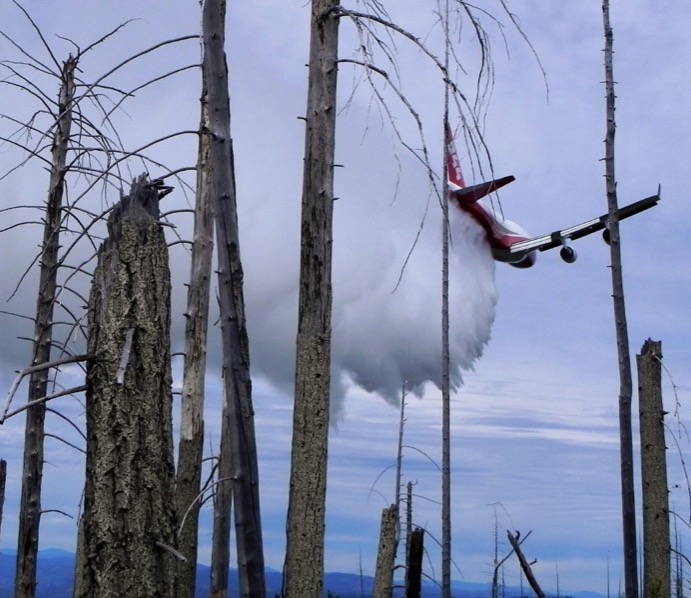Above: A screen grab from the 747 Supertanker video, “Mountain Flying”.
Global SuperTanker bought the retardant system and the intellectual property formerly owned by Evergreen, the organization that first put it in a 747-100 air tanker. It now resides in a 747-400 operated by Global SuperTanker which in recent weeks has been going through some of the final stages of installation, testing, and crew training.

On June 17 the aircraft traveled to Moses Lake, Washington to conduct crew training in mountainous terrain on the Colville Indian Reservation near Moses Lake, Washington. Training flights were under the direction of experienced Lead Plane pilot Jamie Tackman flying a King Air 90, and were recorded by video cameras located on the Keller Butte fire lookout tower and in a helicopter orbiting overhead. Tanker 944, along with the Lead Plane, made seven round trips to the training area, completing a mix of “show me” and low level dry runs plus various full load and segmented water drops.
Downhill, You Tube sharing from Global SuperTanker on Vimeo.
Three FAA inspectors from Denver and Seattle observed the flights.

Jim Wheeler, President and CEO of Global SuperTanker Services, said they do not know if the aircraft will have to go through the retardant drop testing in which the liquid is caught in hundreds of cups placed on the ground. The retardant system is basically the same that was used in Version 1.0 operated by Evergreen, which was previously approved by the Interagency Airtanker Board (IAB). The Board wants some additional data from static drops that will be conducted soon, then a decision will be made about what other data or testing they will need, if any.
Global SuperTanker Services is now preparing the aircraft, ground crew and their facilities for inspections by the FAA, CAL FIRE, U.S. Forest Service, Interagency Airtanker Board, and other state or regional fire agencies interested in CWN (Call When Needed) contracts for the 2016 fire season.
The company has produced videos showcasing the rebirth of the 747 air tanker, Tanker 944. Some have been removed but here is one of them. It appears to have been filmed during the training at the Colville Indian Reservation.


“speed should not be a factor in retardant coverage.” Should have been more specific. Adjusting the drop speed to extend or shorten the retardant coverage level probably isn’t a common fixed-wing practice? Of course there is always the exception, the SEATS. Helicopters on the other hand have a broad range of application speeds hover to 80 m.p.h. When you see the large air tankers making a drop down hill as shown on this site think of a freight train going down a long grade without brakes. Maintaining the initial drop airspeed is an art.
The helicopter owner/pilot who was chartered for the video shoot blogged about the job and touring the 747 afterwards. She does a lot of agricultural flying but has a three axis gyro stabilized camera mount which is presumably why she got this job.
Thanks for the plug, R.
I actually do a wide mix of flying: tours, air taxi and charters (Part 135), aerial photo and video flights, wildlife (mostly raptor) surveys, frost control, corn pollination, and my usual summer work of cherry drying. I’ve done quite a bit of aerial photo and video work, including a bunch of air-to-air shoots, although this was the most challenging of those, mostly because of the danger of wake turbulence. Oddly enough, although I have a 3-axis gyro-stabilized mount, the videographer on this mission opted to use his own; it was a real pity because mine would have been a bit more flexible and easier to use.
Maria, I really enjoyed reading the article you wrote about the filming. Thanks for sharing the story.
Can someone tell me the airspeeds that the 747 / DC10 / C130 are flying when making a drop.
130 to 150 knots is optimum
Johnny – Is the speed based on retardant coverage? Or how hard the retardant is hitting the ground? Thanks for the time!
With the pressurized discharge delivery system air speed management during the drop is very important. Speed should not be the factor for retardant coverage. Minimum drop height for any air tanker is 150 feet above the fire. This allows the retardant time to stop most of its forward travel and cascade down vertically into the target like rain. However the higher the drop the more erosion of the retardant pattern and it is harder to hit the target with height. It is also important that during the drop you don’t allow the aircraft to start to gain altitude towards the end of the tank emptying. Consistent drop airspeed and altitude over the target gets the best results regardless if it is a gravity or pressurized system.
Outstanding! Evergreen got its STC in 2006 and now again. Like to see the VLT’s in formation comparison drops (10-Tanker…all three…and 747)…”Blue Angels Style”…same flight conditions with a bit more than “The Blues'” eighteen-inch tip to tip.
Wouldn’t that be a show?!
https://www.youtube.com/watch?v=VHUBkn8d1vQ